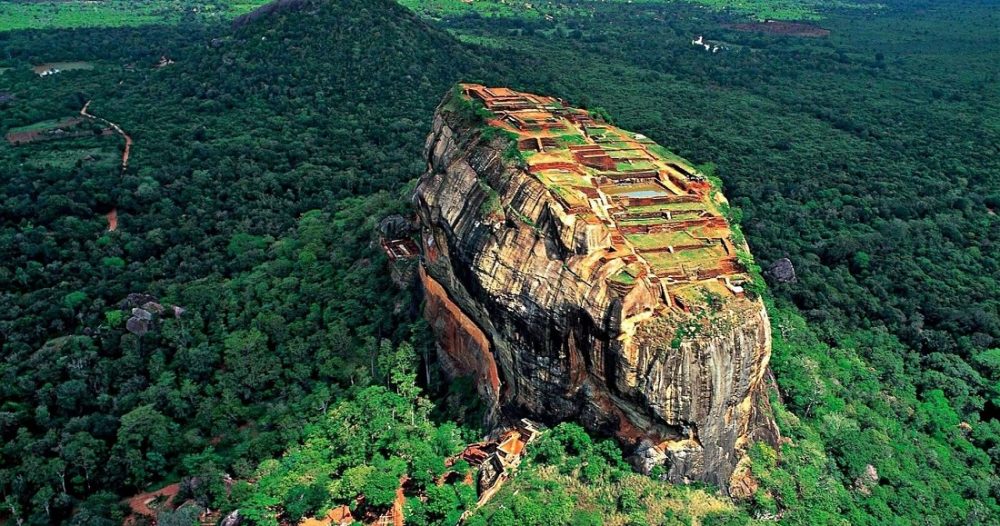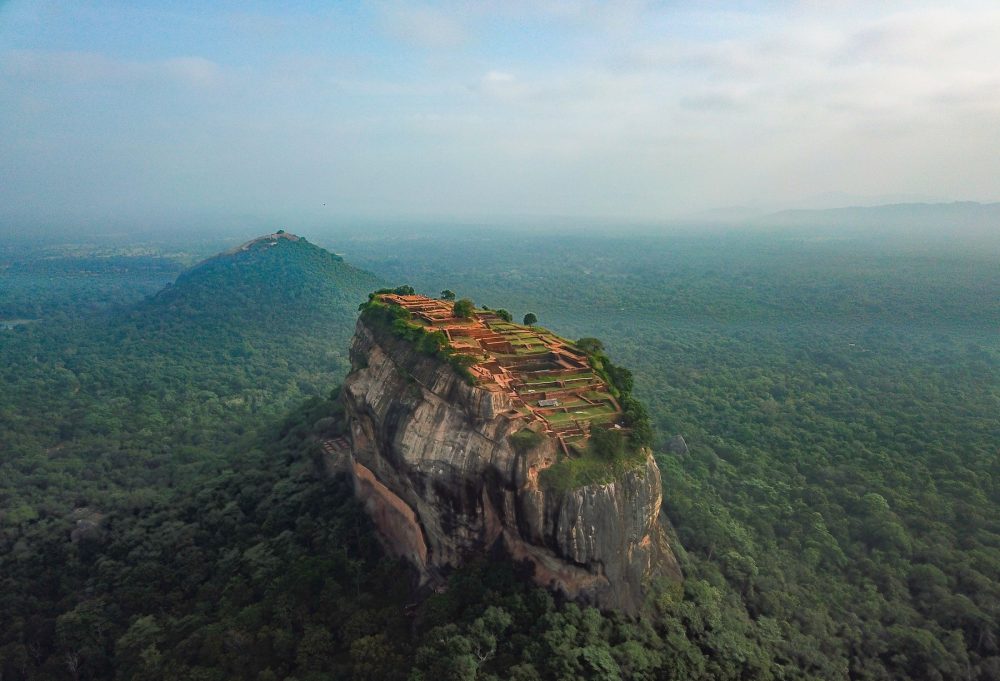This ancient site is considered by many scholars the eighth wonder of the world.

It’s an unacknowledged ancient wonder of the world
Near-vertical walls soar to a flat-topped summit that safeguards the ruins of an ancient civilization.
Hidden atop a strange 200-meter high geological formation lie the magnificent ancient ruins of a temple reaching for the stars: Sigiriya. This ancient site is considered by many scholars the eighth wonder of the world.

Sigiriya is considered one of the most valuable historical monuments of Sri Lanka. Rightfully, this ancient ‘city’ is the most visited tourist attraction in the country.
This ancient rock fortress located in the northern Matale District near Dambulla’s town includes remnants of a ruined palace, surrounded by an extensive network of fortifications, vast gardens, ponds, canals, alleys, and fountains.
This article brings you 25 facts about an ancient rock fortress city, unlike any other.
Sigiriya is one of the UNESCO-listed World Heritage Sites. It is one of the best-preserved examples of ancient urban planning.
The name of this place is derived from this structure—Sīhāgiri, the Lion Rock.
The term Sigiriya originates from the word Sihagri, i.e., Lion Rock.
The archeological site is located on a massive geological formation rising 200 meters.

Geologists noted that the Sigiriya rock is a remnant of an eruption of hardened magma of an extinct and long-eroded volcano.
The ancient city is thought to be one of the most important urban planning sites of the first millennium. Experts argue that the site plan is considered very elaborate and imaginative.
According to experts, Shigiriya’s site plan combines a wide range of symmetry and asymmetry concepts, intentionally interlocking the surroundings’ human-made geometrical and natural forms.
Sigiriya features several water-retaining structures and sophisticated surface and subsurface hydraulic systems, some of which—incredibly—remain operational until today.
The site was both a palace and a fortress.
The ancient city is home to the oldest landscaped gardens in the world.
The site’s gardens are divided into three different but connected forms: water gardens, cave and boulder gardens, and terraced gardens.
Sigiriya is home to the so-called Mirror Wall. This structure was so well polished in the distant past that the king could see his reflection when walking alongside it.
The site is regarded as one of the oldest tourist attractions globally, as people have rushed to visit the place for more than a thousand years.
Some scholars—Lal Srinivas and Mirando Obesekara—believe that Sigiriya may be the Alakamandava (the City of the Gods) built up before 50 centuries ago by King Kubera.
It is believed that during the third century B.C., the rocky plateau of Sigiriya served as a monastery. However, in the second half of the 5th-century, King Kasyapa decided to construct a royal residence.
King Kashyapa revolutionized the site, developing it into a complex city and fortress. He built a wide range of elaborate structures on the rock summit as well as around it. He erected defensive structures, palaces, and gardens, as well as religious structures.
After his death, Sigiriya became a Buddhist monastery until the 14th century, when it was partially abandoned.
According to the Palm Leaf Book (Puskola Potha) of Ravana Watha, the architect of Sigiriya’s ancient rock fortress city was Maya Danava. In Hindu mythology, Maya was a great ancient king of the asura, daitya and rākṣasa races. Maya was known for his brilliant architecture. In Mahabharatha, Mayasabha, the hall of illusions, was named after him.
The architecture and design of Sigiriya are out of this world. The entire rock-fortress was designed in the shape of a huge lion, whose massive feet remain standing today, despite his body being destroyed in the distant past.
The area where Sigiriya is located has been inhabited since very ancient times. Researchers have found evidence that many rock shelters and caves around the ancient site have been inhabited by Buddhist monks as early as the third century B.C.
The Sigiriya Rock shows signs of habitation from five thousand years ago, during the Mesolithic Period.

The site was rediscovered in 1831 when Major Jonathan Forbes of the 78th Highlanders of the British army found a “bush covered summit of Sigiriya.”
The first archaeological work at Sigiriya started in the 1890s.
H.C.P. Bell—a British civil servant and a commissioner in the Ceylon Civil Service, born in British India—was the first archaeologist to conduct extensive research on Sigiriya.
![Ancient City of Sigiriya, Sri Lanka [Amazing Places 4K]](https://i.ytimg.com/vi/IQZIXZRXmGE/hqdefault.jpg)
Related Post
A shocking documentary proves that mermaids do exist
SHOCKING Revelation: Thuya, Mother of Queen Tiye, Was the Grandmother of Akhenaten and Tutankhamun—What Ancient Egyptian Secrets Did She Leave Behind?
Breaking News: Astonishing Discoveries at Karahan Tepe Confirm an Extraterrestrial Civilization is Hiding on Earth, and NO ONE Knows!
Breaking News: Researchers FINALLY Discover U.S. Navy Flight 19 After 75 Years Lost in the Bermuda Triangle!
NASA’s Secret Investigation: Uncovering the Astonishing Mystery of the UFO Crash on the Mountain!
Explosive UFO Docs LEAKED: Startling Proof That Aliens Ruled Ancient Egypt!